Trigeminal injury causes kappa opioid-dependent allodynic, glial and immune cell responses in mice
- PMID: 20109235
- PMCID: PMC2826348
- DOI: 10.1186/1744-8069-6-8
Trigeminal injury causes kappa opioid-dependent allodynic, glial and immune cell responses in mice
Abstract
Background: The dynorphin-kappa opioid receptor (KOR) system regulates glial proliferation after sciatic nerve injury. Here, we investigated its role in cell proliferation following partial ligation of infraorbital nerve (pIONL), a model for trigeminal neuropathic pain. Mechanical allodynia was enhanced in KOR gene deleted mice (KOR-/-) compared to wild type mice. Using bromodeoxyuridine (BrdU) as a mitotic marker, we assessed cell proliferation in three different areas of the trigeminal afferent pathway: trigeminal nucleus principalis (Vp), trigeminal root entry zone (TREZ), and trigeminal ganglion (TG).
Results: In KOR-/- mice or norBNI-treated mice, the number of proliferating cells in the Vp was significantly less than in WT mice, whereas cell proliferation was enhanced in TREZ and TG. The majority of the proliferating cells were nestin positive stem cells or CD11b positive microglia in the Vp and macrophages in the TG. GFAP-positive astrocytes made a clear borderline between the CNS and the PNS in TREZ, and phosphorylated KOR staining (KOR-p) was detectable only in the astrocytes in CNS in WT mice but not in KOR-/- or norBNI-treated mice.
Conclusions: These results show that kappa opioid receptor system has different effects after pIONL in CNS and PNS: KOR activation promotes CNS astrocytosis and microglial or stem cell proliferation but inhibits macrophage proliferation in PNS. The trigeminal central root has a key role in the etiology and treatment of trigeminal neuralgia, and these newly identified responses may provide new targets for developing pain therapies.
Figures


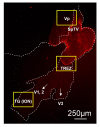

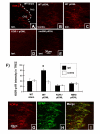
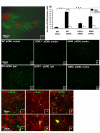
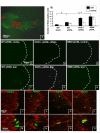
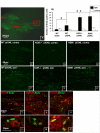
Similar articles
-
Activation of glia and microglial p38 MAPK in medullary dorsal horn contributes to tactile hypersensitivity following trigeminal sensory nerve injury.Pain. 2006 Apr;121(3):219-231. doi: 10.1016/j.pain.2005.12.023. Epub 2006 Feb 21. Pain. 2006. PMID: 16495005
-
Glial Plasticity in the Trigeminal Root Entry Zone of a Rat Trigeminal Neuralgia Animal Model.Neurochem Res. 2019 Aug;44(8):1893-1902. doi: 10.1007/s11064-019-02824-2. Epub 2019 Jun 17. Neurochem Res. 2019. PMID: 31209727
-
Sciatic nerve ligation-induced proliferation of spinal cord astrocytes is mediated by kappa opioid activation of p38 mitogen-activated protein kinase.J Neurosci. 2007 Mar 7;27(10):2570-81. doi: 10.1523/JNEUROSCI.3728-06.2007. J Neurosci. 2007. PMID: 17344394 Free PMC article.
-
Neuropathic pain activates the endogenous kappa opioid system in mouse spinal cord and induces opioid receptor tolerance.J Neurosci. 2004 May 12;24(19):4576-84. doi: 10.1523/JNEUROSCI.5552-03.2004. J Neurosci. 2004. PMID: 15140929 Free PMC article.
-
Biomarkers of glial cell proliferation and differentiation in culture.Front Biosci (Schol Ed). 2010 Jan 1;2(2):558-70. doi: 10.2741/s85. Front Biosci (Schol Ed). 2010. PMID: 20036968 Review.
Cited by
-
TNFα levels and macrophages expression reflect an inflammatory potential of trigeminal ganglia in a mouse model of familial hemiplegic migraine.PLoS One. 2013;8(1):e52394. doi: 10.1371/journal.pone.0052394. Epub 2013 Jan 11. PLoS One. 2013. PMID: 23326332 Free PMC article.
-
Trigeminal neuralgia and genetics: A systematic review.Mol Pain. 2021 Jan-Dec;17:17448069211016139. doi: 10.1177/17448069211016139. Mol Pain. 2021. PMID: 34000891 Free PMC article.
-
Orofacial neuropathic pain mouse model induced by Trigeminal Inflammatory Compression (TIC) of the infraorbital nerve.Mol Brain. 2012 Dec 28;5:44. doi: 10.1186/1756-6606-5-44. Mol Brain. 2012. PMID: 23270529 Free PMC article.
-
Central terminal sensitization of TRPV1 by descending serotonergic facilitation modulates chronic pain.Neuron. 2014 Feb 19;81(4):873-887. doi: 10.1016/j.neuron.2013.12.011. Epub 2014 Jan 23. Neuron. 2014. PMID: 24462040 Free PMC article.
-
Does the kappa opioid receptor system contribute to pain aversion?Front Pharmacol. 2014 Nov 17;5:253. doi: 10.3389/fphar.2014.00253. eCollection 2014. Front Pharmacol. 2014. PMID: 25452729 Free PMC article. Review.
References
-
- Xu M, Petraschka M, McLaughlin JP, Westenbroek RE, Caron MG, Lefkowitz RJ, Czyzyk TA, Pintar JE, Terman GW, Chavkin C. Neuropathic pain activates the endogenous kappa opioid system in mouse spinal cord and induces opioid receptor tolerance. J Neurosci. 2004;24:4576–4584. doi: 10.1523/JNEUROSCI.5552-03.2004. - DOI - PMC - PubMed
Publication types
MeSH terms
Substances
Grants and funding
LinkOut - more resources
Full Text Sources
Research Materials
Miscellaneous

